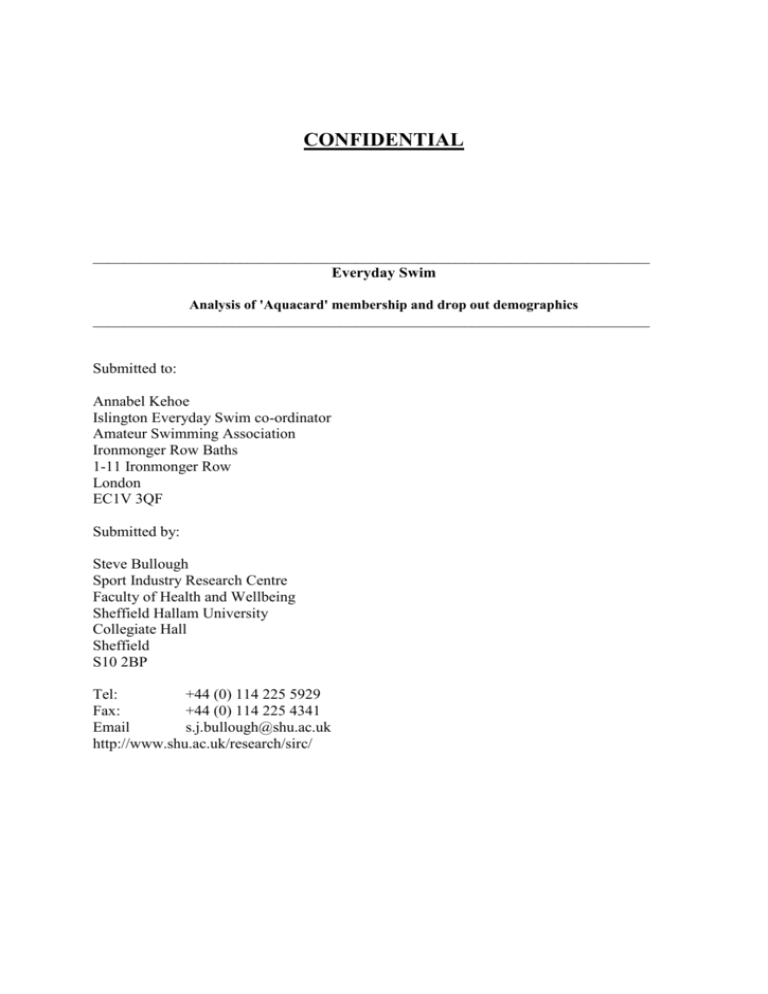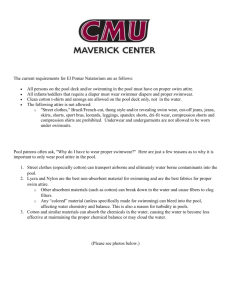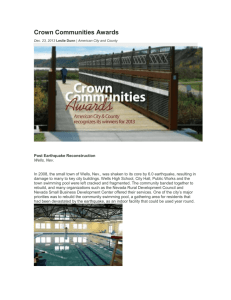- Swimming.Org
advertisement

CONFIDENTIAL ________________________________________________________________________ Everyday Swim Analysis of 'Aquacard' membership and drop out demographics ________________________________________________________________________ Submitted to: Annabel Kehoe Islington Everyday Swim co-ordinator Amateur Swimming Association Ironmonger Row Baths 1-11 Ironmonger Row London EC1V 3QF Submitted by: Steve Bullough Sport Industry Research Centre Faculty of Health and Wellbeing Sheffield Hallam University Collegiate Hall Sheffield S10 2BP Tel: +44 (0) 114 225 5929 Fax: +44 (0) 114 225 4341 Email s.j.bullough@shu.ac.uk http://www.shu.ac.uk/research/sirc/ Analysis of 'Aquacard' membership and drop out demographics The age and gender of those people holding Aquaterra 'Aquaqcard' membership (designed for those people who want to use the facilities to swim) and those people who had terminated 'Aquacard' membership were supplied for analysis. The following two tables highlight the results from those lists in relation to participation data for swimming from Active People. Table 1: Age, gender and facility the member signed up at for current Aquaterra members Under 16 16-19 20-24 25-29 30-44 45-59 60-69 70+ Total No. 3 1 42 161 364 165 5 2 743 Percent 0.4 0.1 5.7 21.7 49.0 22.2 0.7 0.3 100.0 Active People 16.8 17.4 16.6 18.0 13.3 10.3 5.0 13.8 Male Female Total No. 392 388 780 Percent 50.6 49.4 100.0 Active People 10.0 17.0 13.8 Proportion of 100 swimmers* 17 18 17 18 14 11 5 Index** 1 32 127 265 163 7 6 Proportion of 100 swimmers* 37 63 Index** 137 78 * Proportion of 100 swimmers is the amount of people you would expect to swim if the Active People data was applied to 100 people i.e. Active People males / (Active People males + females) *100 (10/27) *100 = 37. ** Index numbers are a useful way of identifying variations within groups. All things being equal it might be expected that male members who would account for 37 of every 100 swims according to the Active People data set, would also account for 37% of membership. However, in reality males appear to be over represented in membership terms as evidenced by the index score of 137 i.e. membership percentage / proportion of swims (50.6/37) *100 = 137. Archway Pool Cally Pool Highbury Pool Ironmonger Row Other dry site Total No. 48 106 310 299 17 848 Percent 5.7 12.5 36.6 35.3 2.0 100.0 Table 1 highlights that almost half of all Aquaterra members are aged between 30 and 44 with only the 45-59 (22.2%) and 25-29 (21.7%) age categories having significant levels of membership. The membership levels by those 24 and under is low with only 46 members although the swimming participation levels for this group are above the national average. The index numbers show that those in the 25-29, 30-44 and 45-59 groups are over represented and those in the other groups are under represented in terms of Aquacard membership. Analysis by gender shows that there is no major difference between males and females in terms of current membership, although in reference to Active People, females are much more likely to swim than males. The index numbers show that male members are over represented compared to what would be expected from the Active People data. The two most popular sites where people signed up were Highbury Pool (39.7% or 310 people) and Ironmonger Row Pool (38.8% or 299 people). Table 2 shows the demographics of those people who have terminated their membership with Aquaterra. Table 2: Age, gender and the facility signed up at of Aquaterra membership terminations Under 16 16-19 20-24 25-29 30-44 45-59 60-69 70+ Total Male Female Total No. 0 2 87 238 375 121 4 0 827 No. 349 499 848 Percent 0.0 0.2 10.5 28.8 45.3 14.6 0.5 0.0 100.0 Percent 41.2 58.8 100.0 Active People 16.8 17.4 16.6 18.0 13.3 10.3 5.0 13.8 Active People 10.0 17.0 13.8 Proportion of 100 swimmers* 17 18 17 18 14 11 5 Proportion of 100 swimmers* 37 63 Index** 1 59 169 245 107 5 0 Index** 111 93 * Proportion of 100 swimmers is the amount of people you would expect to swim if the Active People data was applied to 100 people i.e. Active People 16-19 / SUM(Active People 16-19:70+) *100 (16.8/97.4) *100 = 17. ** Index numbers are a useful way of identifying variations within groups. All things being equal it might be expected that male members who would account for 37 of every 100 swims according to the Active People data set, would also account for 37% of those people cancelling membership. However, in reality males appear to be over represented in cancellations terms as evidenced by the index score of 111 i.e. cancellation percentage / proportion of swims (41.2/37) *100 = 111. Archway Pool Cally Pool Highbury Pool Ironmonger Row Dry Site Total No. 95 81 298 345 29 848 Percent 11.2 9.6 35.1 40.7 3.4 100.0 Table 2 shows that those aged 30-44 are most likely to terminate their membership (45.3%) although as this is the age category with the most members it also has the highest level of swimming participation according to Active People. It is worth noting that almost 29% of those terminating their membership were in the 25-29 age range which is relatively high given the smaller age range of only 5 years and the above average participation rate. Those people aged 25-29 and 30-44 are over represented in terms of cancellations as the index scores show. The data also shows that females are more likely to cancel their membership than males (58.8% cf. 41.2% males) even with a much higher participation rate in swimming, although the index scores suggest that the gender representation of the cancellations is relatively similar. The facility where the former members signed up at shows that Ironmonger Row Pool has the highest number of people who signed up there dropping out (40.7%) with Highbury Pool the next highest (35.4%). It is worth noting here that although these two pools have the majority of members terminating their agreement, they are also the two facilities that have the highest number of people signing up. There is a caveat which needs to be outlined at this stage regarding analysis of the facility which the members signed up at. As members can use all four Aquaterra pools under the terms of their membership it can not be known which pool they utilised the most, therefore is not possible to associate terminations accurately to the performance of a particular facility without making assumptions. It could be assumed that the facility the member signed up at is their local pool and therefore would be the one they would be most likely to use, but without this being proven it would be unwise to generalise this assumption to all members. The data for both members and those who cancelled their membership was cross tabulated by gender and age and also in relation to which pool the member signed up at. Tables 3 to 6 show the results of the analysis. Table 3 begins by showing the number of people who signed up at each pool by gender. Table 3: Ratio of gender in relation to facility signed up at Archway Pool Cally Pool Highbury Pool Ironmonger Row Pool Other dry site Gender Male Female Count Ratio Count Ratio 15 31 33 69 52 49 54 51 132 43 178 57 184 62 115 38 9 53 8 47 Table 3 highlights that males are more likely to become members at Ironmonger Row with a ratio of 62:38, followed by Highbury Pool although the proportion of women signing up in comparison is higher. Females are more likely to become a member at Highbury Pool followed by Ironmonger Row although the proportion of females signing up here in relation to males is lower. For those who sign up at Archway pool, they are much more likely to be female. The age of those people who signed up was also analysed by the facility they signed up at. Table 4: Age and facility of membership sign up Archway Pool Cally Pool Highbury Pool Ironmonger Row Pool Other dry site No. 0 0 1 0 0 16-19 Row % 0.0% 0.0% 0.3% 0.0% 0.0% No. 4 6 15 13 3 20-24 Row % 9.1% 6.1% 5.1% 4.5% 18.8% No. 8 17 74 59 4 25-29 Row % 18.2% 17.3% 25.3% No. 21 41 130 20.3% 25.0% 168 4 30-44 Row % 47.7% 41.8% 44.5% No. 11 33 69 57.9% 25.0% 45-59 Row % 25.0% 33.7% 23.6% 47 5 16.2% 31.3% No. 0 1 1 60-69 Row % 0.0% 1.0% 0.3% 3 0 1.0% 0.0% No. 0 0 2 70+ Row % 0.0% 0.0% 0.7% 0 0 Table 4 shows that all four pools have the highest number of members signing up from the 30-44 age range, with Ironmonger Row having almost 58% of its membership sign ups from this group. It may be worth looking at whether there any underlying reasons why this occurs, also any reasons why Highbury Pool has a higher proportion of people from the 25-29 group and also at Cally Pool for the 45-59 category. Table 5 outlines the gender split for those people who cancelled their membership. Table 5: Drop out figure by gender in relation to facility signed up at Gender Male Archway Pool Cally Pool Highbury Pool Ironmonger Row Pool Other Count 26 28 116 166 13 Row % 27.4% 34.6% 38.9% 48.1% 44.8% Female Count Row % 69 72.6% 53 65.4% 182 61.1% 179 51.9% 16 55.2% 0.0% 0.0% Table 5 shows that for those people who cancelled their membership, females are more likely to cancel their membership than males. By individual pool, Archway Pool has the highest level of females cancelling in comparison to males. For the two pools with the highest sign up and cancellation numbers, Highbury Pool has a higher proportion of females dropping out (a difference of 66 people) compared to Ironmonger Row where the difference is only 13 people. This is due to a lower number of males dropping out from Highbury Pool. Table 6: Age split for those who dropped out No 0 0 1 Archway Pool Cally Pool Highbury Pool Ironmonger Row Pool Other 1 0 16-19 Row % 0.0% 0.0% 0.3% 0.3% 0.0% No 13 9 34 30 1 20-24 Row % 14.0% 11.7% 11.7% 8.9% 3.4% No 24 20 84 25-29 Row % 25.8% 26.0% 29.0% 104 5 30.8% 17.2% 30-44 No Row % 46 49.5% 31 40.3% 114 39.3% 171 15 50.6% 51.7% No 10 16 55 31 8 45-59 Row % 10.8% 20.8% 19.0% 9.2% 27.6% No 60-69 Row % 0 0.0% 1 1.3% 2 0.7% 1 0 Table 6 shows that for those people cancelling their Aquacard, people aged 30-44 are more likely to cancel their membership, especially if they signed up at Archway and Ironmonger Row (approx 50%). The spread across age categories is relatively even when looking at the data by pool but it may be worth investigating the reasons behind a higher proportion of members in the 45-59 group cancelling at Cally and Highbury. However, as stated earlier, the sign up and drop out percentages may not reflect the pool in which the member used the most therefore these results need to be viewed with this caveat in mind. When trying to put the data in context, Table 7 shows the sign up and cancellation percentages for the two pools which have the highest number of members split by the three most populated age brackets. Table 7: Sign up and cancellation analysis by most populated age brackets for Highbury Pool and Ironmonger Row 25-29 Highbury IRB Sign up 25.3% 20.3% Drop out 29.0% 30.8% 30-44 Variance -3.6% -10.4% Sign up 44.5% 57.9% Drop out 39.3% 50.6% 45-59 Variance 5.2% 7.3% Sign up 23.6% 16.2% Drop out 19.0% 9.2% Variance 4.7% 7.0% Sign up 36.6% 35.3% Overall Drop out Variance 35.1% 1.5% 40.7% -5.4% Table 7 suggests that there are a higher proportion of people terminating their membership in the 2529 age group who signed up at Ironmonger Row Pool than there are at Highbury Pool. Highbury Pool has a higher retention of members in the 30-44 group but Ironmonger Row has a higher retention for the 45-59 bracket. It may be worth looking at the underlying reasons behind the 10.4% variance at Ironmonger Row for the 25-29 group, and also if there is anything from Highbury Pool that could be used at Ironmonger Row given the difference overall in retention. Conclusions The report has shown some insight into the basic demographics of members and former members which could be used as benchmarks for the future, albeit under consideration of the caveats to which this data is subject. The market intelligence approach to membership can supply useful information in which the ES team can use in a similar way to 'dry' side membership analysis and retention. 0.3% 0.0%






